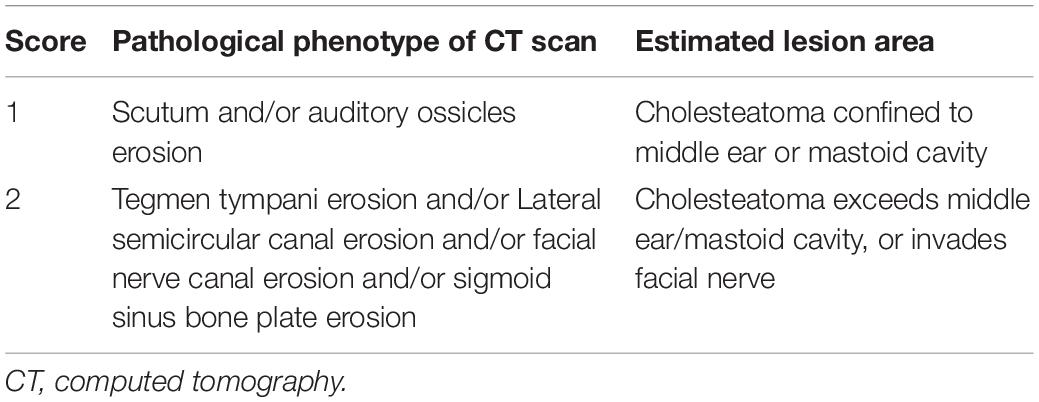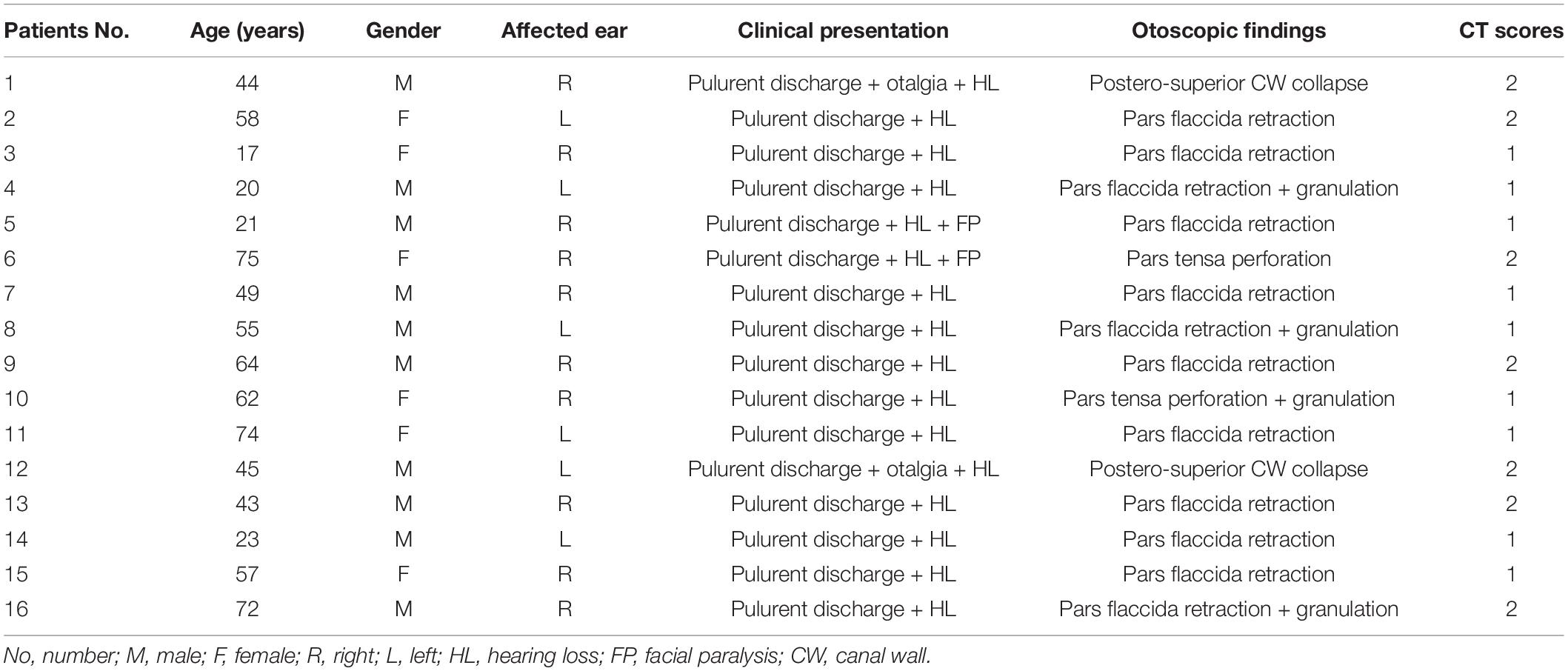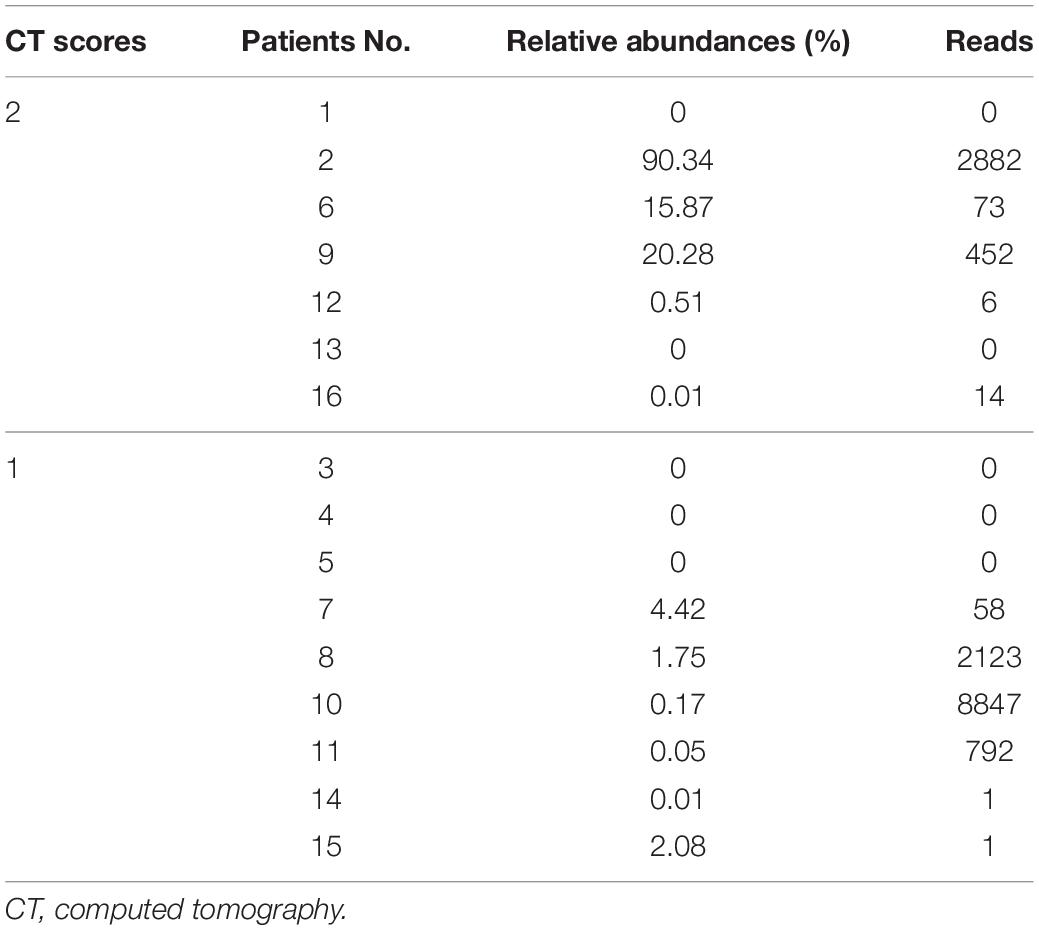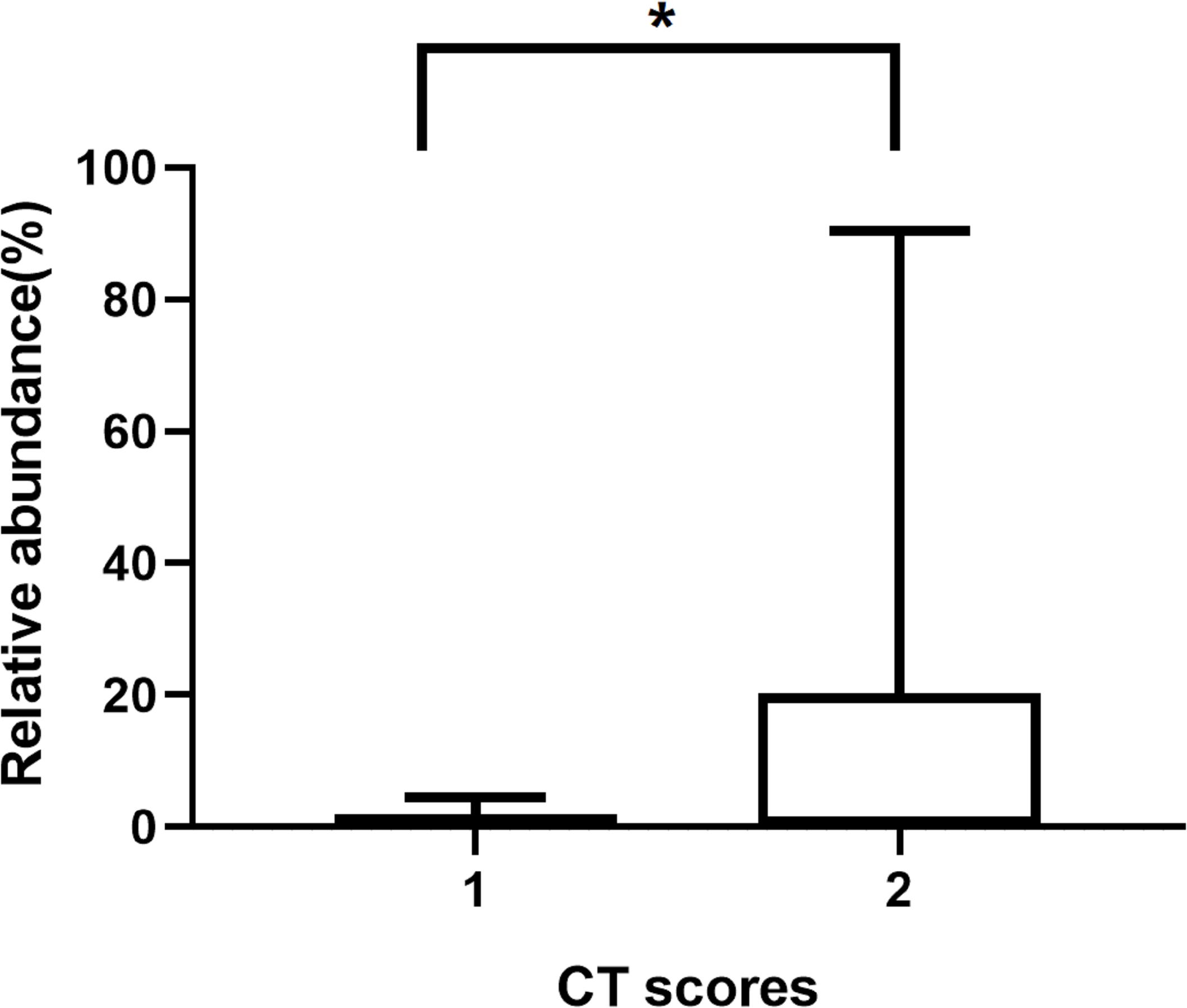- 1Department of Otolaryngology, The Second Affiliated Hospital, Zhejiang University School of Medicine, Hangzhou, China
- 2Eye Center of the Second Affiliated Hospital, Institute of Translational Medicine, Zhejiang University School of Medicine, Hangzhou, China
- 3Hangzhou Matridx Biotechnology Co., Ltd., Hangzhou, China
- 4The Children’s Hospital, Zhejiang University School of Medicine, National Clinical Research Center for Child Health, Hangzhou, China
An acquired cholesteatoma generally occurs as a consequence of otitis media and eustachian tube dysfunction. Patients with acquired cholesteatoma generally present with chronic otorrhea and progressive conductive hearing loss. There are many microbes reportedly associated with acquired cholesteatoma. However, conventional culture-based techniques show a typically low detection rate for various pathogenetic bacteria and fungi. Metagenomic next-generation sequencing (mNGS), an emerging powerful platform offering higher sensitivity and higher throughput for evaluating many samples at once, remains to be studied in acquired cholesteatoma. In this study, 16 consecutive patients from January 2020 to January 2021 at the Second Affiliated Hospital of Zhejiang University School of Medicine (SAHZU) were reviewed. We detected a total of 31 microbial species in patients, mNGS provided a higher detection rate compared to culture (100% vs. 31.25%, p = 0.000034). As the severity of the patient’s pathological condition worsens, the more complex types of microbes were identified. The most commonly detected microbial genus was Aspergillus (9/16, 56.25%), especially in patients suffering from severe bone erosion. In summary, mNGS improves the sensibility to identify pathogens of cholesteatoma patients, and Aspergillus infections increase bone destruction in acquired cholesteatoma.
Introduction
An acquired cholesteatoma generally occurs as a consequence of otitis media and eustachian tube dysfunction. It is characterized by chronic infection and temporal bone deterioration (Parisier, 1989). Patients with acquired cholesteatoma generally present with chronic otorrhea and progressive conductive hearing loss. In addition to hearing loss, the damaging effects of cholesteatoma can lead to serious complications, such as labyrinthitis, facial paralysis, and brain abscess (Inagaki and Paparella, 2009). Surgery is currently regarded as the only clinical treatment option for cholesteatoma patients, which is directed at eradication of the entrapped keratinized epithelium and keratin from the middle ear and mastoid spaces. The primary goal of surgery is to create a disease-free, or risk-free ears. Nevertheless, medical management is indicated in preparation for a definitive surgical procedure, with no recommendations available to either prevent or cure the disease (Welkoborsky, 2011).
There are various microbes reportedly closely linked to acquired cholesteatoma, most commonly such as Pseudomonas aeruginosa and Staphylococcus aureus (Ricciardiello et al., 2009). Although the etiology of cholesteatoma remains unknown, previous studies have demonstrated that microbial activity may contribute to the pathogenesis and clinical behavior of cholesteatoma (Likus et al., 2016; Kalcioglu et al., 2018). However, to date, studies on the microbes associated with cholesteatoma have relied on traditional culture-based techniques for characterizing the microbiota. Since conventional culture-based techniques have a typically low detection rate due to the unculturability of many bacteria and fungi, more sensitive methods, such as 16S rRNA gene sequencing for bacteria identification have been developed to characterize microbiota (Liu et al., 2011; Kalcioglu et al., 2018; Weiss et al., 2019). The limitation of these studies based on 16S rRNA is obvious, the fungi, viruses and parasites were not considered. More recently, metagenomic next-generation sequencing (mNGS) based on the shotgun approach has been surging used for clinical diagnosis of infections (Mai et al., 2017; Wilson et al., 2017; Fan et al., 2018). Notably, mNGS offers higher sensitivity and high-throughput for evaluating many samples at once, and can provide more (and more reliable) information through sequence data than that is available through traditional culture-based analysis.
To our knowledge, no published study has yet described a mNGS-based evaluation of cholesteatoma-associated microbial communities. In this study, we apply this novel technique to investigate the diversity and composition of microbiota that accompany with cholesteatoma in order to provide insight into how these microbes contribute to the pathogenesis of cholesteatoma.
Materials and Methods
Ethics Statement
This study was reviewed and approved by the Institutional Review Board of SAHZU. Written informed consent was obtained from every patient and all procedures were conducted in accordance with the Declaration of Helsinki.
Case Series
A total of 16 consecutive patients with cholesteatoma received surgery in the otolaryngology department of the Second Affiliated Hospital of Zhejiang University School of Medicine (SAHZU) from January 2020 to January 2021. The cholesteatoma tissue samples were obtained from patients during surgery and were collected in a sterile container. The specimens were sent for microbial bacterial and fungal smear and in our microbiological laboratory and mNGS sequencings and bioinformatic analysis by Hangzhou Matridx Biotechnology Co. All patients received pre-operative temporal bone CT scan and CT scores based on bone erosion (Table 1) were recorded.
Microbial Culture
Mycological analysis was carried out in the Microbiology Department of our hospital. Microscopic examination was performed by Zeiss Axiovert 200 under 40×, to initially detect any direct signs of bacterial or fungal infection in the debris. The remaining tissue samples were cultured on Sabouraud’s Dextrose Agar for assessment of fungal growth and on blood Agar and Mac Conkey’s Agar for bacterial growth. Identification of isolated colonies was based on colony morphology, pigmentation, microscopy, and other standard physiological and biochemical assays (Procop et al., 2017).
DNA Extraction, Metagenomic Sequencing, and Data Analysis
All samples were subjected to DNA extraction (each patient and “no-template” as negative control), library preparation, and next-generation sequencing (NGS). DNA extraction and library preparation were conducted using an NGS Automatic Library Preparation System (Cat. MAR002, MatriDx Biotech Corp., Hangzhou). The reagents included a Nucleic Acid Extraction Kit (Cat. MD013, MatriDx Biotech Corp., Hangzhou) and a Total DNA Library Preparation Kit (other samples) (Cat. MD001T, MatriDx Biotech Corp., Hangzhou). To control the contamination of each sequencing run, each sequencing run on Illumina Next Seq instrument included “no template” as negative control. Quality control was carried out using a bioanalyzer (Agilent 2100, Agilent Technologies, Santa Clara, CA, United States) combined with quantitative PCR to measure the adapters before sequencing. Libraries were pooled and then sequenced on an Illumina NextSeq500 system using a 75-cycle sequencing kit. A total of 10–20 million reads were obtained for each sample.
Metagenomic Next-Generation Sequencing Data Analysis
High quality sequencing data was generated after removal of short (<35 bp) reads, low quality and low complexity reads. The sequencing data was firstly demultiplexed to get the sequence reads of each sample in fastq format. Then, sequence reads of each sample were aligned to human-specific database constructed from Homo sapiens sequences in NCBI nucleotide (nt) database using bowtie2 (Langmead and Salzberg, 2012; Wood et al., 2019) (version 2.3.5.1) for eliminating the human sequences. The remaining reads were aligned to a manual-curated microbial database using kraken2 (confidence = 0.5) for quickly classification and the classified reads of interested microorganisms were aligned again using bowtie2 for validation. Additionally, the result of microorganism classification was used to identify the potential pathogens.
Statistical Analysis
Significant differences in the relative abundance of microbial taxa (i.e., the proportions of each microbe) between patient groups (categorized by CT score) were determined using t-tests. Fisher’s exact test were used to evaluate independent binomial variables (SPSS version 20). The p-value of ≤0.05 was considered statistically significant.
Results
Clinical Findings
Sixteen patients with cholesteatoma were enrolled in this study. Ten were male and six were female, with an age range of 17 to 75 years. Clinical data are shown in Table 2. All patients showed purulent discharge and hearing loss. Two of them presented with otalgia, and two other patients displayed facial paralysis. Most frequently, pre-operation otoscopic findings were pars flaccida retraction (12/16) and three of them had granulation in the retraction pocket. Pars tensa perforation was found in two patients. The two patients who complained of otalgia had external canal collapse, which precluded observation of the tympanic membrane. Seven patients with severe temporal bone erosion were recorded as CT score 2 (Table 2 and Figure 1).
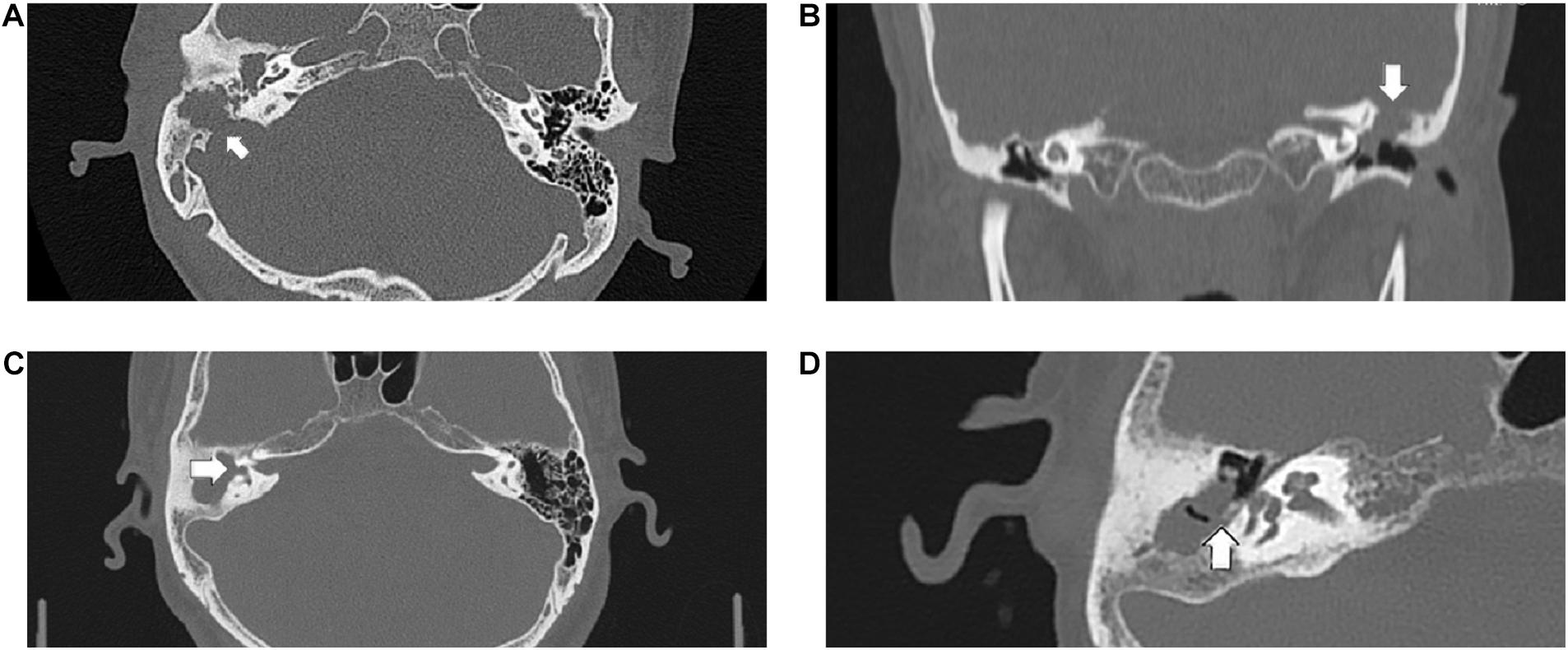
Figure 1. The following CT scan findings were recorded as score 2: (A) the sigmoid sinus bone plate eroded (arrowed), (B) coronal section of the left epitympanum demonstrating a tegmen tympani defect (arrowed), (C) a large defect of the lateral semicircular canal (arrowed), (D) the pyramid segment of facial canal eroded (arrowed).
Microbial Culture Results
Eleven (68.75%) of the 16 patients, were negative for culturable bacteria or fungi (Table 3). In the remaining five patients, bacterial species were successfully cultured and identified in four cholesteatoma specimens, and fungal species were detected in only one specimen. Staphylococcus was the most common bacterial species (75%).
Metagenomic Next-Generation Sequencing Results
Our mNGS reads showed a 100% detection rate of potential pathogens in all cholesteatoma samples (Table 3). After excluding the microbial taxa that obviously originated from the environment or a background source, a total of 31 microbial species, including fungi and bacteria were recognized. Eleven samples (68.75%) had more than two different species, and cholesteatoma-specific microbiota were comprised of 2 to 8 taxa. The most commonly detected microbial genus was Aspergillus (11/16, 68.75%), with a huge variation in read counts (1 to 2882) and relative abundances (0.01% to 90.34%) (Table 3). The second most common genus was Staphylococcus (7/16, 43.75%), with the reads counts ranging from 113 to 1435881 and relative abundances between 1.06% and 90.99% across samples in which was detected (Table 3). The relative abundances of Aspergillus significantly varied between patient groups. Patients with the high CT scores have significantly higher relative abundances of Aspergillus than those with low CT scores (p = 0.023) (Table 4 and Figure 2).
Discussion
Several studies have used mNGS as a tool for universal pathogen detection in infectious disease, thus indicating its potential in clinical diagnoses, particularly in microbiota-associated disorders (Hu et al., 2018; Zhu et al., 2018). The advantages of mNGS sequence-based detection of microbes associated with a disease state include high throughput evaluation that can accommodate many samples at once compared to traditional PCR-based detection, the quantity of data provided by sequence is potentially much higher because bacterial, fungal, and viral community members can be detected simultaneously, and the reliability of sequence data surpasses that of traditional morphological and physiological assays (i.e., Biolog plates) for microbial identification (Jacob, 2013).
It is noteworthy that mNGS successfully identified pathogenic fungi or bacteria in all cases, whereas traditional culture-based identification found pathogenic microbes in only 31.25% of our cholesteatoma cohort. The presence and high relative abundance of microbes found by culture-based methods was confirmed by mNGS data, thereby illustrating the suitability of mNGS for detection of pathogens in cholesteatoma debris. However, the two techniques differed in the most commonly detected microbes, since culture methods showed Staphylococcus as a predominant taxon, while mNGS showed Aspergillus as the most common pathogen associated with cholesteatoma. Besides, Staphylococcus was still the second most common pathogens by mNGS. These mNGS results thus offer a new perspective on the effects incurred by microbiota on the development of cholesteatoma.
Standard textbook descriptions of cholesteatoma have historically included bacteria associated with this disorder, but have almost completely neglected the fungal constituents of the debris. Previous studies of chronic rhinosinusitis biofilms have revealed the presence of fungal constituents (Healy et al., 2008), alternatively, fungal colonization of cholesteatoma had been sparsely studied. Especially two studies cultured the fungi from cholesteatoma tissue (Effat and Madany, 2014; Singh et al., 2018). Singh et al. (2018) cultured 40 cholesteatoma samples and successfully isolated fungi from 17 of the specimens (42.5%). Among these 17 cases, 6 cases had detectable grown of both fungi and bacteria. Effat and Madany (2014) obtained keratinous debris from 18 patients (19 ears) with cholesteatoma and found culturable fungi in 17 of the samples (89%), but reported no data on culturable bacterial. More recently, Weiss et al. (2019) evaluated the microbiota associated with cholesteatoma by 16S rDNA gene sequencing in 19 patients. A total of 96 bacterial species and 34 fungal species were identified in association with the cholesteatoma matrix, but no difference was found between the relative abundance of fungal and bacterial taxa prevalent in the diseased tissue compared with that of the adjacent, uninvolved middle ear.
In our study, we used mNGS to analyze the cholesteatoma microbiome for the presence of pathogens. In contrast with conventional culture methods and 16S rDNA gene sequencing, mNGS offers higher sensitivity and throughput microbial pathogen detection and microbiome analyses due to its capacity for simultaneous detection of bacteria and fungi. In our case series, a total of 12 cases (12/16, 75%) exhibited detectable fungal infection, among which 10 cases (10/16, 62.5%) had both bacterial and fungal microbes, a substantially higher proportion than that reported through culture-based investigation (6/17, 35.3%) (Singh et al., 2018). The common fungal genus specifically associated with cholesteatoma in our cholesteatoma cohort was Aspergillus, differing from the consistent prevalence of Alternaria reported by Weiss et al. (2019). Moreover, only two cases in this study had Aspergillus in the absence of any significant bacterial taxa.
As discussed above, fungi have been found to colonize bacterial biofilms in chronic rhinosinusitis. In cholesteatomas, bacterial biofilms were also detected by electron microscopy (Saunders et al., 2011). In the current study, both bacterial and fungal growth was detected in more than half of the samples, consistent with that fungi also likely reside in bacterial biofilms related to cholesteatomas. Some studies have investigated the interactions between bacteria and fungi and their impact on the efficacy of antimicrobial agents. In chronic rhinosinusitis, for example, fungi and bacteria were found to act synergistically against host defenses and antibiotics (Healy et al., 2008). Studies exploring the mechanism underpinning this phenomenon proposed that fungi could interact with bacteria to become coated in the biofilm matrix which subsequently served as a barrier preventing diffusion of antimicrobial agents and facilitating the secretion and diffusion of polysaccharides by fungal cells (Harriott and Noverr, 2010; Kong et al., 2016). The interaction between fungi and bacteria may be also associated with poor response to antibiotic therapy in cholesteatoma. In future studies, we will explore the mechanism behind this phenomenon of the relationship between Aspergillus and cholesteatoma.
A study by Kauffman et al. (2000) using airway-derived epithelial cell line A549 and primary epithelial nasal cells found that exposure to Aspergillus extracts resulted in cell shrinking, cell desquamation, and proinflammatory cytokine production. More recently, Patel et al. (2019) demonstrated that Aspergillus could stimulate IL-25 secretion and elicit type 2 inflammation in non-invasive fungal rhinosinusitis. It is therefore plausible that Aspergillus could play a role in cholesteatoma progression. To explore this possibility in our study, we used CT scans to evaluate bone erosion related to cholesteatoma and found that Aspergillus infection was identified more often in cases with severe bone erosion, compared with its prevalence in cases with minor bone erosion. Similarly, in allergic fungal rhinosinusitis, Aspergillus was also reportedly associated with bone destruction (Marfani et al., 2010). Many studies have focused on osteoprotegerin (OPG), a receptor activator of nuclear factor κB (RANK) and RANK ligand (RANKL), in cholesteatoma-related bone erosion (Jeong et al., 2006; Kuczkowski et al., 2010; Likus et al., 2016). However, some inconsistencies remain in the relationship between these proteins and cholesteatoma. Specifically, although inflammatory cytokines and bacteria were thought to be correlated with OPG and RANKL expression and bone destruction in cholesteatoma (Haruyama et al., 2010; Kalcioglu et al., 2018), no significant differences were observed in the expression of OPG and RANKL between the cholesteatoma cases with and without bacterial infections (Kalcioglu et al., 2018). Thus, further study the role of fungi and bacteria in bone erosion in cholesteatoma is warranted.
In conclusion, this study represents the first report to our knowledge using mNGS to detect microbes in cholesteatoma samples. It is noteworthy that the most commonly detected microbe specifically associated with cholesteatoma is Aspergillus and its presence is apparently related to increase the degree of bone destruction. This study had some limitations, such as relatively small sample size and use of CT scoring to differentiate disease states instead of healthy control subjects. In addition, the read counts varied greatly between samples. It is possible that water lavage during oto-surgery may have resulted in the loss or reduction in microbial load during surgery. To accommodate this issue in the present study, the cut-off value for potential pathogen detection was set low and at least one unique read was used as a threshold. However, similar methods have been used by other mNGS studies (Miao et al., 2018; Wang et al., 2019). Regardless of its limitations, the results provided by this mNGS analysis likely represent the most accurate characterization of the cholesteatoma microbiota to date and provide insight into how microbial taxa may contribute to the severity of this disease.
Data Availability Statement
The datasets presented in this study can be found in online repositories. The names of the repository/repositories and accession number(s) can be found below: NCBI (accession: PRJNA768391).
Ethics Statement
The studies involving human participants were reviewed and approved by The Second Affiliated Hospital, Zhejiang University School of Medicine. The patients/participants provided their written informed consent to participate in this study. Written informed consent was obtained from the individual(s) for the publication of any potentially identifiable images or data included in this article.
Author Contributions
XC and HJ conceived and designed the study. XC, HJ, and LH analyzed the data. HJ, QW, LS, XO, and HL collected the related clinical information. HJ, CW, JX, XH, JW, and WD conducted the infection samples associated with the study. XH, JW, and WD provided the technical support. XC and HJ wrote the draft. LH, JX, and CW revised the draft. All authors approved the final version. All authors contributed to the article and approved the submitted version.
Funding
This work was supported by grants from the Science Technology Project of Zhejiang Province (Grant Numbers 2018C37058 and LGC19H120002) and the Natural Science Foundation of Zhejiang Province for Distinguished Young Scholar (Grant Number LR21H120001).
Conflict of Interest
XH, JW, and WD are employed by “Matridx Biotechnology Co., Ltd.”
The remaining authors declare that the research was conducted in the absence of any commercial or financial relationships that could be construed as a potential conflict of interest.
Publisher’s Note
All claims expressed in this article are solely those of the authors and do not necessarily represent those of their affiliated organizations, or those of the publisher, the editors and the reviewers. Any product that may be evaluated in this article, or claim that may be made by its manufacturer, is not guaranteed or endorsed by the publisher.
Acknowledgments
We thank the patient for cooperating with our investigation and acknowledge Hangzhou Matridx Biotechnology Company for performing mNGS.
Supplementary Material
The Supplementary Material for this article can be found online at: https://www.frontiersin.org/articles/10.3389/fmicb.2021.761111/full#supplementary-material
References
Effat, K., and Madany, N. (2014). Mycological study on cholesteatoma keratin obtained during primary mastoid surgery. J. Laryngol. Otol. 128:881. doi: 10.1017/S0022215114002059
Fan, S., Ren, H., Wei, Y., Mao, C., Ma, Z., Zhang, L., et al. (2018). Next-generation sequencing of the cerebrospinal fluid in the diagnosis of neurobrucellosis. Int. J. Infect. Dis. 67, 20–24. doi: 10.1016/j.ijid.2017.11.028
Harriott, M. M., and Noverr, M. C. (2010). Ability of Candida albicans mutants to induce Staphylococcus aureus vancomycin resistance during polymicrobial biofilm formation. Antimicrob. Agents Chemother. 54, 3746–3755. doi: 10.1128/AAC.00573-10
Haruyama, T., Furukawa, M., Kusunoki, T., Onoda, J., and Ikeda, K. (2010). Expression of IL-17 and its role in bone destruction in human middle ear cholesteatoma. ORL J. Otorhinolaryngol. Relat. Spec. 72, 325–331. doi: 10.1159/000319897
Healy, D. Y., Leid, J. G., Sanderson, A. R., and Hunsaker, D. H. (2008). Biofilms with fungi in chronic rhinosinusitis. Otolaryngol. Head Neck Surg. 138, 641–647. doi: 10.1016/j.otohns.2008.02.002
Hu, Z., Weng, X., Xu, C., Lin, Y., Cheng, C., Wei, H., et al. (2018). Metagenomic next-generation sequencing as a diagnostic tool for toxoplasmic encephalitis. Ann. Clin. Microbiol. Antimicrob. 17:45. doi: 10.1186/s12941-018-0298-1
Inagaki, T., and Paparella, M. M. (2009). Chronic otitis media with cholesteatoma: middle ear/inner ear interaction. Otol. Neurotol. 30, 430–431. doi: 10.1097/MAO.0b013e31818600db
Jacob, H. J. (2013). Next-generation sequencing for clinical diagnostics. N. Engl. J. Med. 369, 1557–1558. doi: 10.1056/NEJMe1310846
Jeong, J. H., Park, C. W., Tae, K., Lee, S. H., Shin, D. H., Kim, K. R., et al. (2006). Expression of RANKL and OPG in middle ear cholesteatoma tissue. Laryngoscope 116, 1180–1184. doi: 10.1097/01.mlg.0000224345.59291.da
Kalcioglu, M. T., Guldemir, D., Unaldi, O., Egilmez, O. K., Celebi, B., and Durmaz, R. (2018). Metagenomics analysis of bacterial population of tympanosclerotic plaques and cholesteatomas. Otolaryngol. Head Neck Surg. 159, 724–732. doi: 10.1177/0194599818772039
Kauffman, H. F., Tomee, J. C., Van De Riet, M. A., Timmerman, A. J., and Borger, P. (2000). Protease-dependent activation of epithelial cells by fungal allergens leads to morphologic changes and cytokine production. J. Allergy Clin. Immunol. 105, 1185–1193. doi: 10.1067/mai.2000.106210
Kong, E. F., Tsui, C., Kucharíková, S., Andes, D., Van Dijck, P., and Jabra-Rizk, M. A. (2016). Commensal protection of Staphylococcus aureus against antimicrobials by Candida albicans biofilm matrix. MBio 7, e1365–16. doi: 10.1128/mBio.01365-16
Kuczkowski, J., Sakowicz-Burkiewicz, M., and Iżycka-Świeszewska, E. (2010). Expression of the receptor activator for nuclear factor-κB ligand and osteoprotegerin in chronic otitis media. Am. J. Otolaryngol. 31, 404–409. doi: 10.1016/j.amjoto.2009.06.004
Langmead, B., and Salzberg, S. L. (2012). Fast gapped-read alignment with Bowtie 2. Nat. Methods 9:357. doi: 10.1038/nmeth.1923
Likus, W., Siemianowicz, K., Markowski, J., Wiaderkiewicz, J., Kostrza̧b-Zdebel, A., Jura-Szołtys, E., et al. (2016). Bacterial infections and osteoclastogenesis regulators in men and women with cholesteatoma. Arch. Immunol. Ther. Exp. 64, 241–247. doi: 10.1007/s00005-015-0373-7
Liu, C. M., Cosetti, M. K., Aziz, M., Buchhagen, J. L., Contente-Cuomo, T. L., Price, L. B., et al. (2011). The otologic microbiome: a study of the bacterial microbiota in a pediatric patient with chronic serous otitis media using 16SrRNA gene-based pyrosequencing. Arch. Otolaryngol. Head Neck Surg. 137, 664–668. doi: 10.1001/archoto.2011.116
Mai, N. T. H., Phu, N. H., Nhu, L. N. T., Hong, N. T. T., Hanh, N. H. H., Nguyet, L. A., et al. (2017). Central nervous system infection diagnosis by next-generation sequencing: a glimpse into the future? Open Forum Infect. Dis. 4:ofx046. doi: 10.1093/ofid/ofx046
Marfani, M., Jawaid, M., Shaikh, S., and Thaheem, K. (2010). Allergic fungal rhinosinusitis with skull base and orbital erosion. J. Laryngol. Otol. 124:161. doi: 10.1017/S0022215109991253
Miao, Q., Ma, Y., Wang, Q., Pan, J., Zhang, Y., Jin, W., et al. (2018). Microbiological diagnostic performance of metagenomic next-generation sequencing when applied to clinical practice. Clin. Infect. Dis. 67, S231–S240. doi: 10.1093/cid/ciy693
Parisier, S. C. (1989). Management of cholesteatoma. Otolaryngol. Clin. North Am. 22, 927–940. doi: 10.1016/S0030-6665(20)31368-2
Patel, N. N., Triantafillou, V., Maina, I. W., Workman, A. D., Tong, C. C., Kuan, E. C., et al. (2019). Fungal extracts stimulate solitary chemosensory cell expansion in noninvasive fungal rhinosinusitis. Int. Forum Allergy Rhinol. 9, 730–737. doi: 10.1002/alr.22334
Procop, G. W., Church, D., Hall, G., and Janda, W. (2017). Koneman’s Color Atlas and Textbook of Diagnostic. Philadelphia: Wolters Kluwer.
Ricciardiello, F., Cavaliere, M., Mesolella, M., and Iengo, M. (2009). Notes on the microbiology of cholesteatoma: clinical findings and treatment. Acta Otorhinolaryngol. Ital. 29:197.
Saunders, J., Murray, M., and Alleman, A. (2011). Biofilms in chronic suppurative otitis media and cholesteatoma: scanning electron microscopy findings. Am. J. Otolaryngol. 32, 32–37. doi: 10.1016/j.amjoto.2009.09.010
Singh, G. B., Solo, M., Kaur, R., Arora, R., and Kumar, S. (2018). Mycology of chronic suppurative otitis media-cholesteatoma disease: an evaluative study. Am. J. Otolaryngol. 39, 157–161. doi: 10.1016/j.amjoto.2017.12.001
Wang, S., Chen, Y., Wang, D., Wu, Y., Zhao, D., Zhang, J., et al. (2019). The feasibility of metagenomic next-generation sequencing to identify pathogens causing tuberculous meningitis in cerebrospinal fluid. Front. Microbiol. 10:1993. doi: 10.3389/fmicb.2019.01993
Weiss, J. P., Antonelli, P. J., and Dirain, C. O. (2019). Microbiome Analysis of Cholesteatoma by Gene Sequencing. Otol. Neurotol. 40, 1186–1193. doi: 10.1097/MAO.0000000000002355
Welkoborsky, H. (2011). Current concepts of the pathogenesis of acquired middle ear cholesteatoma. Laryngorhinootologie 90, 38–48. doi: 10.1055/s-0030-1268464
Wilson, M. R., Suan, D., Duggins, A., Schubert, R. D., Khan, L. M., Sample, H. A., et al. (2017). A novel cause of chronic viral meningoencephalitis: cache Valley virus. Ann. Neurol. 82, 105–114. doi: 10.1002/ana.24982
Wood, D. E., Lu, J., and Langmead, B. (2019). Improved metagenomic analysis with Kraken 2. Genome Biol. 20:257. doi: 10.1186/s13059-019-1891-0
Zhu, Y.-M., Ai, J.-W., Xu, B., Cui, P., Cheng, Q., Wu, H., et al. (2018). Rapid and precise diagnosis of disseminated T. marneffei infection assisted by high-throughput sequencing of multifarious specimens in a HIV-negative patient: a case report. BMC Infect. Dis. 18:379. doi: 10.1186/s12879-018-3276-5
Keywords: acquired cholesteatoma, metagenomic next-generation sequencing (mNGS), microbes, infection, Aspergillus
Citation: Jiang H, Wu C, Xu J, Wang Q, Shen L, Ou X, Liu H, Han X, Wang J, Ding W, Hu L and Chen X (2021) Bacterial and Fungal Infections Promote the Bone Erosion Progression in Acquired Cholesteatoma Revealed by Metagenomic Next-Generation Sequencing. Front. Microbiol. 12:761111. doi: 10.3389/fmicb.2021.761111
Received: 19 August 2021; Accepted: 11 October 2021;
Published: 05 November 2021.
Edited by:
María Guembe, Gregorio Marañón Hospital, SpainReviewed by:
Bernard Joseph Hudson, New South Wales Health Pathology, AustraliaAldert Zomer, Utrecht University, Netherlands
Copyright © 2021 Jiang, Wu, Xu, Wang, Shen, Ou, Liu, Han, Wang, Ding, Hu and Chen. This is an open-access article distributed under the terms of the Creative Commons Attribution License (CC BY). The use, distribution or reproduction in other forums is permitted, provided the original author(s) and the copyright owner(s) are credited and that the original publication in this journal is cited, in accordance with accepted academic practice. No use, distribution or reproduction is permitted which does not comply with these terms.
*Correspondence: Lidan Hu, aHVsaWRhbkB6anUuZWR1LmNu; Xiangjun Chen, Y2hlbnhpYW5nanVuQHpqdS5lZHUuY24=
†These authors have contributed equally to this work
 Hua Jiang
Hua Jiang Chengpeng Wu
Chengpeng Wu Jingjie Xu
Jingjie Xu Qi Wang1
Qi Wang1 Lei Shen
Lei Shen Jun Wang
Jun Wang Wenchao Ding
Wenchao Ding Xiangjun Chen
Xiangjun Chen